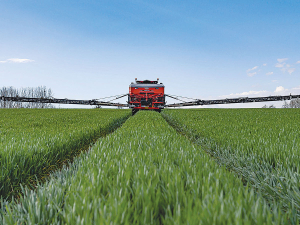Disc mower range gets upgrade
Kuhn has announced an expansion of its range of disc mowers, distributed by Norwood in New Zealand, with the addition of two new vertically folding rear mounted models, the GMD 3515 and GMD 4015.
 The spreader makes it possible to precisely deliver the right dose of fertiliser in the right place.
The spreader makes it possible to precisely deliver the right dose of fertiliser in the right place.
The new AERO 32.1 mounted, pneumatic fertiliser spreader offers working widths of 24, 27, 28, or 30 metres, to complete KUHN’s range of pneumatic fertiliser spreaders.
Fitted with a boom equipped with 24 diffusers (20 for the 24m version) that are divided into four sections, the AERO 32.1 fertiliser spreader makes it possible to precisely deliver the right dose of fertiliser in the right place.
Each section is fed by a switchable, hydraulically driven metering unit that can be adjusted individually, making it possible to modulate up to four fertiliser application rates or to shut-off individual boom sections in a single pass.
The AERO 32.1 also incorporates two weighing cells that measure the quantity of fertiliser remaining in the hopper and, if necessary, the operator can adjust the application rate by altering the speed of the metering units without a calibration test.
Fine, light, or compound fertilisers, such as urea and bulk type mixtures are typically difficult to distribute over larger spreading widths with centrifugal spreaders, but the AERO 32.1 offers precise application, right up to paddock boundaries, delivering significant savings.
With cultivation windows appearing to get shorter each season, the AERO 32.1 boom style system makes it possible to apply fertiliser in any weather conditions, even on the windiest days.
The ballistic qualities of individual fertilisers or seeds no longer matter and operators do not need to keep checking spreading tables. Similarly, the optional fine metering roller can spread a variety of material, including slug pellets, micro-granules, or even small seeds for broadcasting cover crops.
Hydraulically controlled booms fold at the rear of the hopper and well within the dimensions needed for transport.
The machine and booms can be managed via the CCI 800 or 1200 terminal or any other ISOBUS terminal already available. The use of a CCI A3 joystick is an optional extra.
Following the release to Northern European markets in 2024, availability in New Zealand, although yet to be confirmed, is expected to be in the latter part of 2025.
Farmer confidence has taken a slight dip according to the final Rabobank rural confidence survey for the year.
Former Agriculture Minister and Otaki farmer Nathan Guy has been appointed New Zealand’s Special Agricultural Trade Envoy (SATE).
Alliance Group has commissioned a new heat pump system at its Mataura processing plant in Southland.
Fonterra has slashed another 50c off its milk price forecast as global milk flows shows no sign of easing.
Meat processors are hopeful that the additional 15% tariff on lamb exports to the US will also come off.
Fears of a serious early drought in Hawke’s Bay have been allayed – for the moment at least.